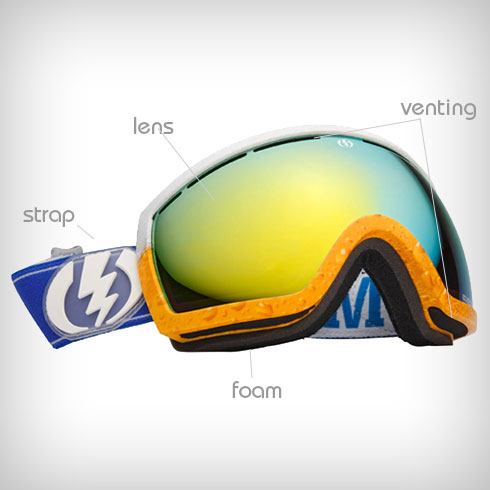Goggles are an important part to your snowboard setup. You might ask, “Can’t I just wear my shades?”. Snowboard goggles have many advantages over sunglasses when riding. For one, they protect you from bright conditions and snow reflections much better than sunglasses by wrapping your entire field of vision with shade. Two, they stay on a lot better. Riding can get bumpy and shades can slip off pretty easily. Third, Goggles will stop wind that can easily blur your vision. Goggles are a good idea to ride with for all skill levels to maximize your vision and ride harder, faster and safer in any snow condition.
Use this guide to navigate the tech that makes some goggles perform different than others in various light conditions.
shape
The lens shape of a goggle can make a huge difference in performance. Here are the two shapes and their advantages:
- Cylindrical: These are usually found on low to mid priced goggles. While they are curved side to side to wrap around your face the lens itself has a flat surface. The flatness will reduce the peripheral vision of the goggle. They can also slightly distort your vision. For an infrequent rider these are a good affordable option.
- Spherical: These lens are curved from top to bottom and side to side. This is similar to how glasses or contact lenses are curved. These are generally found on more expensive goggles. These provide better peripheral vision will less distortion. The effect is pretty noticible so if you have room in your budget they are worth the extra money.
lens color
Different colors of goggle lenses are designed to work in different light conditions. Many pairs will come with an extra lens. If you don’t want to spend the money on multiple lenses then it is best to go with an all around lens. This will work for just about anything mother nature throws at you. Also note that many brands make mirrored lens options which reduces glare and helps enhance depth perception on bright days. Here is a break down of some lens tints and what they work best for arranged by the lens that works best bright conditions down to overcast conditions:

Grey
Awesome for the blue bird days. Helps increase contrast and blocks the sun. These lenses come mirrored for extra glare reduction and improved contrast.
Dark Brown
Very similar to grey but lets a little more light through. Again, these lenses come mirrored for extra glare reduction and improved contrast.
Orange
A great all around lens. Helps bring out bumps and depth perception while providing some protection on sunny days.
Amber
Similar to an orange lens but will be a little better on the fog and overcast days.
Green
Helps increase contrast. Best for moderate light days.
Yellow
Another popular all around lens. Great for the very foggy and overcast days. Can still use it on a blue bird day though.
Rose
Helps increase depth perception. Next to clear it is usually the top choice for night riding.
Clear
The ultimate in night conditions. This simply keeps the wind, snow and other nasty stuff out of your eyes.
visual light transmission
While this sounds like a fancy term it is pretty basic. This is simply the amount of light that passes through the lens of the goggle. Reffered to as a percentage, the lower the number the more light it will block and vise versa. This helps you to understand what conditions they would work well in. A VLT of 6% would let much less light in than a 76%, therefore would work much better on a brighter day. Remember that while a goggle may allow more light through it does not change the amount of UV protection it provides.
frame size
Over the past several years the goggle frame sizes have expanded into many different options. It used to be one size for everyone. Now brands are pushing the limits with larger, oversized frames. You don’t necessarily need a large head to ride an oversized fram. The idea is that a larger frame will provide more peripheral vision. Combining an oversized frame with a spherical lens on some models makes it almost seem like you’re not even wearing goggles.
It is always best to try on in person if possible to be sure you like the fit of the frame to your face. Most brands make goggles built for men, women and kids so that is a good place to start your search. If you ride with a helmet, make sure that the frame fits without any discomfort or blocking of vision.
foam and venting
Different levels of goggles in terms of quality many times include different types of foam and different methods of venting. You might see two or three layer foam in higher end goggles making for a better fit and more comfortable ride throughout the day. The quaility of venting will also often get better with a higher end goggle. Vents on a goggle control the airflow in and out of the goggle and help to prevent fogging. If you’ve ever been in the middle of a double black and had your goggles fog up, you know exactly how much that sucks. Higher quality goggles will have multiple vents on the top, bottom and around the goggle for optimal airflow in and out to prevent the evil fog.
strap
Not too much tech here but it is an important part of making the goggle good at what it does. After all of that protection you still something to keep it locked down on your noggin! Straps are generally one size fits all adjustable but make sure you are looking at goggles that match your gender for the best fit. Not only will the frame size fit better, the strap will fit better. If you wear a helmet, most straps will expand to stretch around the helmet.
